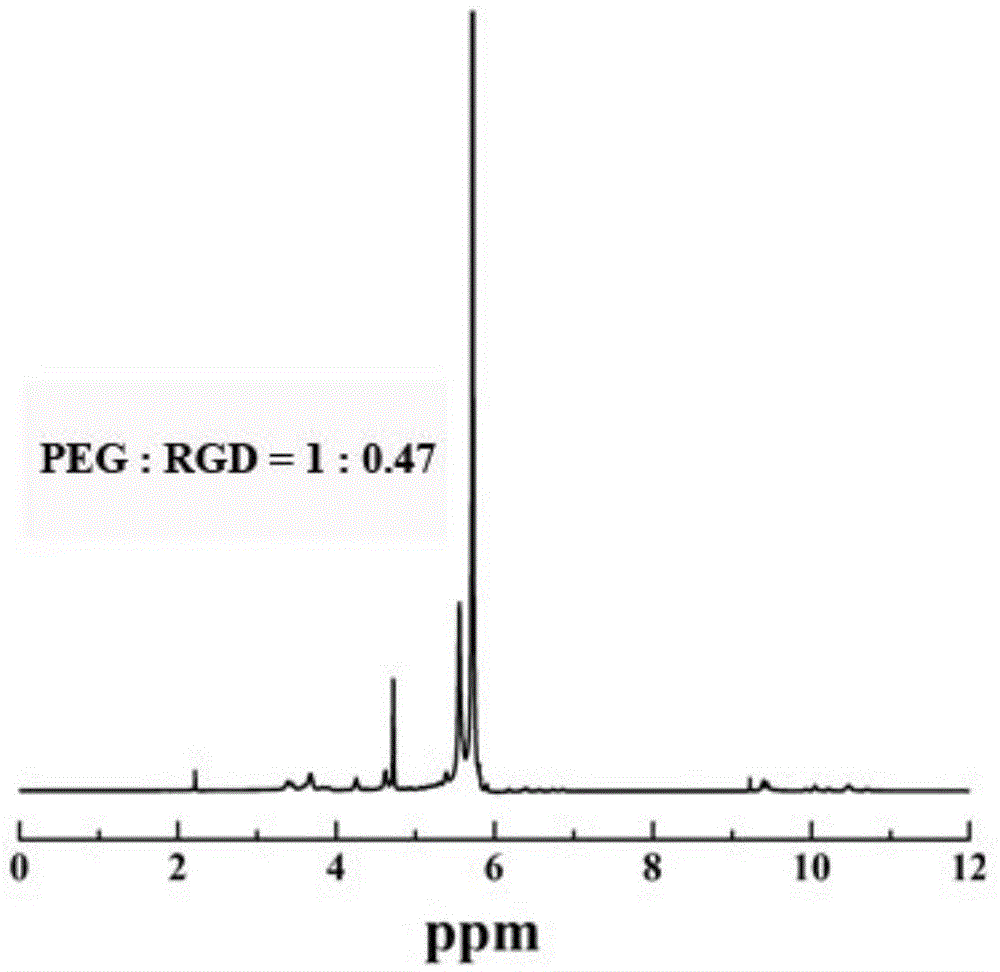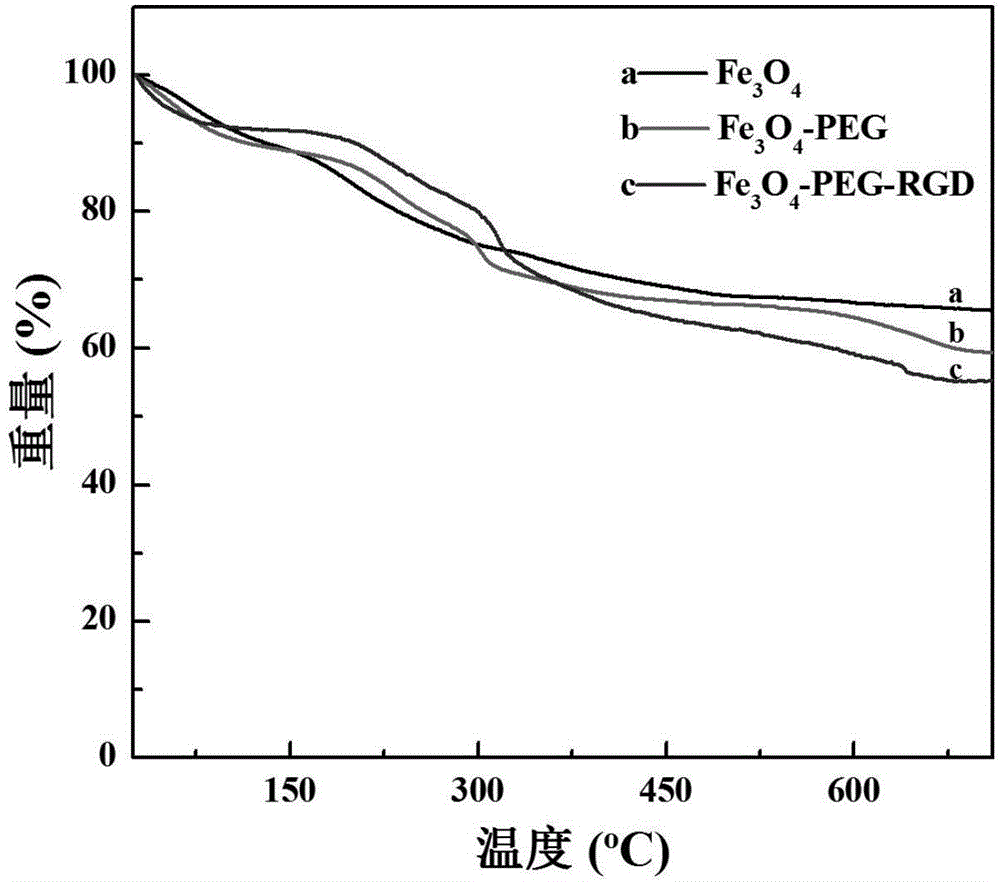Method for preparing RGD peptide targeted ultra-small ferriferrous oxide MRI positive nanoprobe
A technology of ultra-small iron ferric oxide and ferric iron tetroxide, applied in preparations for in vivo tests, pharmaceutical formulations, etc., can solve problems such as difficult biological functionalization and no discovery, and achieve increased water solubility and biophase Capacitive, easy to operate, easy to prepare
- Summary
- Abstract
- Description
- Claims
- Application Information
AI Technical Summary
Problems solved by technology
Method used
Image
Examples
Embodiment 1
[0067] 1.09g of ferric chloride hexahydrate was dissolved in 40mL of diethylene glycol (also known as diethylene glycol, DEG), and then 0.47g of sodium citrate (Na 3 Cit) was dissolved in the above solution, and stirred at 80° C. for 1 hour under an air atmosphere. After the sodium citrate was completely dissolved, 1.312 g of anhydrous sodium acetate was added to the above solution, and the stirring was continued until the sodium acetate powder was completely dissolved, and then Transfer the solution to a 50mL autoclave, and react at 200°C for 4 hours; after the reaction, cool to room temperature naturally, transfer the product to a 50mL centrifuge tube and centrifuge at 8500rpm for 15 minutes, discard the supernatant, and return to the solution with absolute ethanol. Dissolve, centrifuge at 8500rpm for 15 minutes, repeat the operation 3 times, and then dry the precipitate at 60°C to obtain ultra-small ferric oxide nanoparticles; from the surface potential and hydrated particle...
Embodiment 2
[0073] Get the Fe prepared by embodiment 1 respectively 3 o 4 , Fe 3 o 4 -Fe prepared by PEG-RGD nanoparticles and comparative example 1 3 o 4 -Dissolve 2 mg of PEG nanoparticles in ultrapure water to obtain a nanoparticle suspension, which is homogenized by ultrasound, and the surface potential and hydrated particle size are measured. The experimental results show that the prepared Fe 3 o 4 , Fe 3 o 4 -PEG-RGD and Fe 3 o 4 The surface potentials of -PEG nanoparticles were -39.7, -10.1 and -8.8mV; the hydrated particle diameters were 14.6, 212.5 and 168.7nm. From the changes of surface potential and hydrated particle size, it can be concluded that PEG or PEG-RGD has been successfully modified on the surface of Fe3O4 nanoparticles.
[0074] Take by weighing two kinds of materials that embodiment 1 prepares respectively: Fe 3 o 4 , Fe 3 o 4 The control group material Fe obtained by -PEG-RGD and comparative example 1 3 o 4 -PEG 2mg for infrared spectroscopy test ...
Embodiment 3
[0078] In order to ensure that the nanoparticles prepared by the present invention can be safely used for in vivo bioimaging diagnosis, the prepared Fe 3 o 4 -PEG-RGD nanoparticles and control material Fe 3 o 4 -PEG blood compatibility was evaluated. Calculate and weigh Fe according to the iron concentration calculation of two kinds of materials measured in embodiment 2 3 o 4 -PEG-RGD nanoparticles (embodiment 1) and contrast material Fe 3 o 4 -Two kinds of nanoparticles with 1 mg of total iron in PEG (comparative example 1) were respectively dispersed in PBS to prepare a concentration of 1 mg / mL as the mother liquor, and then the concentrations of 10 μg / mL, 20 μg / mL, and 40 μg were sequentially prepared in PBS / mL, 60 μg / mL and 80 μg / mL nanoparticle suspensions. Take an appropriate amount of human fresh blood, first centrifuge (2000rpm, 5 minutes) to remove the supernatant, then wash the red blood cells 5 times with PBS, collect healthy red blood cells and dilute them ...
PUM
| Property | Measurement | Unit |
|---|---|---|
| diameter | aaaaa | aaaaa |
| diameter | aaaaa | aaaaa |
| particle size | aaaaa | aaaaa |
Abstract
Description
Claims
Application Information
 Login to View More
Login to View More - R&D
- Intellectual Property
- Life Sciences
- Materials
- Tech Scout
- Unparalleled Data Quality
- Higher Quality Content
- 60% Fewer Hallucinations
Browse by: Latest US Patents, China's latest patents, Technical Efficacy Thesaurus, Application Domain, Technology Topic, Popular Technical Reports.
© 2025 PatSnap. All rights reserved.Legal|Privacy policy|Modern Slavery Act Transparency Statement|Sitemap|About US| Contact US: help@patsnap.com



